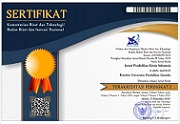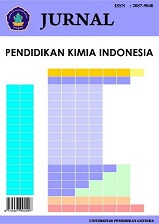The Development of ChemicoMine, Maritime Chemistry Comic Webtoon as an Edutainment Media Accordance to the IMO Regulations
DOI:
https://doi.org/10.23887/jpki.v8i2.82417Keywords:
ChemicoMine, Maritime Chemistry Comic, Webtoon, IMO, EdutainmentAbstract
Based on the IMO Model Course 7.04 curriculum, chemistry is an introductory course that a candidate for sailor must master. However, most abstract chemistry concepts require technology-based learning media and edutainment. Webtoon is a digital comic that presents the concept of chemistry through real-life visualization strategies to attract student interest. This research aimed to create ChemicoMine, a maritime chemistry comic webtoon whose material content follows IMO regulations. The research method is R&D with the ADDIE model, which is limited to the Development stage. The instruments used in this research were analyst instruments of necessity, the validation tools of storyboard, the instrument validated by an expert in media and material, and the instrument for students. The data analysis techniques used the Likert scale 5. Validation results from an expert in material and media stated that the product received a percentage rating of 87.66% and 95.28% with the category (very good). Student response results obtained percentage of rating of 88.94% with the category (very good). Based on the results, ChemicoMine received a positive student response and can be used as an alternative edutainment media.
References
Aksu, M., & Yilmaz, R. . (2021). The effectiveness of comic-based teaching materials in science education. Journal of Science Education and Technology, 30(2), 234–245. https://doi.org/10.1007/s10956-021-09936-1
Aliifah, N. J., Ramli, M., & Yunita, L. (2023). Pengembangan Media Pembelajaran Komik Webtoon Terintegrasi STEM pada Mata Pelajaran Kimia Materi Gaya Antarmolekul. SPIN-Jurnal Kimia & Pendidikan Kimia, 5(1), 112–126. https://doi.org/10.20414/spin.v5i1.7020
Annisa, S. A., Lesmono, A. D., & Yushardi, Y. (2020). Comic-Based Module Development Andro-Web to Improve Problem Solving Ability in Physics in High School Students. Berkala Ilmiah Pendidikan Fisika, 8(1), 40. https://doi.org/10.20527/bipf.v8i1.7641
Arisandi, Y., Ibnu, S., Subandi, S., & Sumari, S. (2021). Vocational high school students’ motivation towards learning chemistry. AIP Conf. Proc., 2330. https://doi.org/10.1063/5.0043417
Budiarti, W. N., & Haryanto, H. (2016). Pengembangan Media Komik Untuk Meningkatkan Motivasi Belajar Dan Keterampilan Membaca Pemahaman Siswa Kelas Iv. Jurnal Prima Edukasia, 4(2), 233. https://doi.org/10.21831/jpe.v4i2.6295
Damayanti, A. E., & Kuswanto, H. (2020). The use of android-assisted comics to enhance students’ critical thinking skill. Journal of Physics: Conference Series, 1440(1). https://doi.org/10.1088/1742-6596/1440/1/012039
Diah, L., Pratiwi, A., & Mu’minin, A. A. (2023). Pengembangan Media Pembelajaran Komik Berbasis Android Pada Materi Hakikat Ilmu Kimia Untuk Siswa Kelas X Di MAN 1 Kota Kediri. 2(4), 221–233. http://jurnal.anfa.co.id/index.php/seroja
Dixon, C., & Turner, R. (2022). Integrating mobile technology and comics in education: A practical approach. International Journal of Mobile and Blended Learning, 14(1), 45–62. https://doi.org/10.4018/IJMBL.20220101.oa3
Halawa, A. A., Yulita, I., & Adriani, N. (2022). The development of Acid-Base Electronic Chemistry Comic Learning Media for High School Students. Journal of Science Education Research, 6(1), 24–30. https://doi.org/10.21831/jser.v6i1.44997
Hernandez-de-Menendez, M., Escobar Diaz, C. ., & Morales-Menendez, R. (2020). Educational experiences with Generation Z. Int J Interact Des Manuf, 14, 847–859. https://doi.org/10.1007/s12008-020-00674-9
Ikhwanus Shofa, M., Wayan Redhana, I., & Prima Juniartina, P. (2020). Analisis Kebutuhan Pengembangan Media Pembelajaran Ipa Berbasis Argument Mapping. 3(April), 31–40.
Ilmi, S. N., Mawarnis, E. R., Herman, M., Studi, P., Kimia, T., Islam, U., Mahmud, N., & Batusangkar, Y. (2023). Pengembangan Media Pembelajaran E-Comic Kimia Berbasis Stem (Science, Technology, Engineering, Dan Mathematic) Pada Materi Termokimia Untuk Kelas XI MIPA SMA YDB Lubuk Alung. Jurnal Pendidikan Tambusai, 7(1), 2966–2975.
IMO. (2014). Model Course 7.04 Officer in Charge of An Engineering Watch.
Kerimbayev, N., Umirzakova, Z., Shadiev, R., & Jotsov, V. (2023). A student-centered approach using modern technologies in distance learning: a systematic review of the literature. Smart Learn. Environ, 10(61). https://doi.org/10.1186/s40561-023-00280-8
Krause, S. (2022). Visual storytelling in comics: Enhancing comprehension in science learning. International Journal of Science Education, 44(5), 747–764. https://doi.org/10.1080/09500693.2021.1974543
Kunto, I., Ariani, D., Widyaningrum, R., & Syahyani, R. (2021). Ragam Storyboard Untuk Produksi Media Pembelajaran. Jurnal Pembelajaran Inovatif, 4(1), 108–120. https://doi.org/10.21009/jpi.041.14
Lestari, A. F. (2020). Line Webtoon Sebagai Industri Komik Digital. Jurnal Ilmu Komunikasi, 6, 134–148.
M. Arsyad, M. K. K., Nurhayati, N., & Yani, A. (2022). Pengembangan Komik Fisika Berbantuan Aplikasi Linewebtoon. Jurnal Sains Dan Pendidikan Fisika, 18(2), 171. https://doi.org/10.35580/jspf.v18i2.31525
Makmun. (2021). Balo Lipa: Jurnal Pendidikan Seni Rupa Komik : Media Komunikasi Pembelajaran. Jurnal Pendidikan Seni Rupa, 18–23.
Minawati, D., Nanda, D. S., Sihotang, M. D., & Kusmindari, C. D. (2021). an Analysis of Using Webtoon in Improving Students’ Reading Motivation At First Semester. Beyond Linguistika, 4(2). https://doi.org/10.36448/bl.v4i2.2313
Muller, R., & Schulte, E. (2022). Visualizing chemistry: The role of comics in the teaching and learning of chemistry. Chemistry Education Research and Practice, 23(3), 689–700. https://doi.org/10.1039/D1RP00234H
Musnur, I., & Faiz, M. (2019). Analisis Penyajian Karakter Dan Alur Cerita Pada Komik Vulcaman-Z. Narada : Jurnal Desain Dan Seni, 6(2), 339. https://doi.org/10.22441/narada.2019.v6.i2.010
Naila, N., Winarti, A., & Mahdian, M. (2022). Pengembangan Media Pembelajaran Komik Kimia Bermuatan Literasi Sains Untuk Meningkatkan Pemahaman Konsep Dan Kemampuan Komunikasi Peserta Didik. Quantum: Jurnal Inovasi Pendidikan Sains, 13(1), 1. https://doi.org/10.20527/quantum.v13i1.11817
Novianti, R., & Putra, A. (2020). Development of Chemistry Comics as Alternative Learning Media on Electrolyte and Non Electrolyte Solution for Grade X SMA. International Journal of Research and Review (Ijrrjournal.Com), 7(9), 25.
Nugraha, D. A. (2020). Pengembangan Komik Kimia Sebagai Media Pembelajaran Berbasis Cet (Chemo-Edutainment). Chemistry in Education, 9(2), 1–7. http://journal.unnes.ac.id/sju/index.php/chemined
Nurinayati, F., Sartono, N., & Evriyani, D. (2018). Development of Digital Comic as Learning Media on Immune System Topic in SMAN 13 Jakarta. Biosfer, 7(2), 47–52. https://doi.org/10.21009/biosferjpb.7-2.8
Otto, S., Bertel, L. ., Lyngdorf, N. E. ., Markman, A. ., Andersen, T., & Ryberg, T. (2024). Emerging Digital Practices Supporting Student-Centered Learning Environments in Higher Education: A Review of Literature and Lessons Learned from the Covid-19 Pandemic. Education and Information Technologies, 29, 1673–1696. https://doi.org/10.1007/s10639-023-11789-3
Parastuti, & Prihandari, I. (2021). Pengantar Manga (Komik Jepang). CV Jejak.
Payanti, D. A. K. D. (2022). Peran Komik Digital sebagai Media Pembelajaran Bahasa yang Inovatif. Sandibasa I: Seminar Nasional Pendidikan Bahasa Dan Sastra Indonesia I, 4(April), 464–475. https://ojs.mahadewa.ac.id/index.php/sandibasa/article/download/2035/1484
Pratiwi, A., & Junaidi, I. (2021). Mobile learning applications to improve scientific inquiry skills among high school students. International Journal of Educational Technology in Higher Education, 18(1), 12. https://doi.org/10.1186/s41239-021-00256-1
Rahman, F., & Mulyono, S. (2022). Utilizing local environmental issues to boost student engagement in science learning. International Journal of Science Education, 44(9), 1351–1370. https://doi.org/10.1080/09500693.2022.2043992
Rahmi, C., Mujakir, & Febriani, P. (2021). Kemampuan Representasi Submikroskopik Siswa Pada Konsep Ikatan Kimia. Lantanida Journal, 9(1), 1–92.
Ramadhan, B. S., & Rasuardie, R. (2020). Kajian Industri Komik Daring Indonesia: Studi Komik Tahilalats. JSRW (Jurnal Senirupa Warna), 8(1), 2–18. https://doi.org/10.36806/jsrw.v8i1.80
Sankar, E., & Benjamin, A. E. . (2024). Studying the student’s perceptions of engagement and problem-solving skills for academic achievement in chemistry at the higher secondary level. Education and Information Technologies, 29(7), 1–22. https://doi.org/10.1007/s10639-023-12165-x
Sari*, S. A., & Exaudie Lubis, M. T. (2021). Development of Android Chemistry Comics as an Independent Learning Application to Improve Student Learning Outcomes. Jurnal Pendidikan Sains Indonesia, 9(3), 433–444. https://doi.org/10.24815/jpsi.v9i3.20266
Sugiyono. (2017). Metode Penelitian Kuantitatif, Kualitatif, dan R&D. Alfabeta CV.
Suprianingsih, N., Yenti, E., & Kurniawati, Y. (2022). Pengembangan Bahan Ajar Komik Terintegrasi Islam Pada Materi Hakikat Ilmu Kimia. Journal of Chemistry Education and Integration, 1(1), 16. https://doi.org/10.24014/jcei.v1i1.15901
Suryaningsih, S., & Nisa, F. A. (2021). Kontribusi Steam Project Based Learning dalam Mengukur Keterampilan Proses Sains dan Berpikir Kreatif. Jurnal Pendidikan Indonesia, 2(6), 1097–1111.
Wulan, I. S., Suprapto, P. K., & Kamil, P. M. (2020). Belajar Virus dengan Komik: Pengaruhnya terhadap Motivasi dan Hasil Belajar (Studi Eksperimen di Kelas X MAN Tasikmalaya Tahun Ajaran 2019/2020). Bioedusiana: Jurnal Pendidikan Biologi, 5(2), 70–83. https://doi.org/10.37058/bioed.v5i2.2005
Yolanda, R., Harlin, H., & Yadi, F. (2020). Pengembangan Media Komik Pada Mata Kuliah Teknologi Motor Diesel Di Pendidikan Teknik Mesin Universitas Sriwijaya. Jurnal Pendidikan Teknik Mesin, 97–108.
Zhou, Y., & Zhang, H. (2021). Connecting classroom learning to real-world issues: Enhancing student motivation in science education. Journal of Educational Research, 114(3), 281–290. https://doi.org/10.1080/00220671.2020.1760079
Downloads
Published
How to Cite
Issue
Section
License
Copyright (c) 2024 Khoirotun Nafillah, Dhesi Wulan Sari, Purwanto Purwanto

This work is licensed under a Creative Commons Attribution-ShareAlike 4.0 International License.
Authors who publish with the Jurnal Pendidikan Kimia Indonesia agree to the following terms:
- Authors retain copyright and grant the journal the right of first publication with the work simultaneously licensed under a Creative Commons Attribution License (CC BY-SA 4.0) that allows others to share the work with an acknowledgment of the work's authorship and initial publication in this journal.
- Authors are able to enter into separate, additional contractual arrangements for the non-exclusive distribution of the journal's published version of the work (e.g., post it to an institutional repository or publish it in a book), with an acknowledgment of its initial publication in this journal.
- Authors are permitted and encouraged to post their work online (e.g., in institutional repositories or on their website) prior to and during the submission process, as it can lead to productive exchanges, as well as earlier and greater citation of published work. (See The Effect of Open Access)





